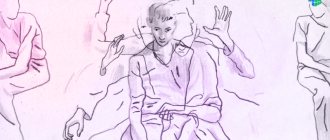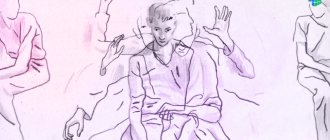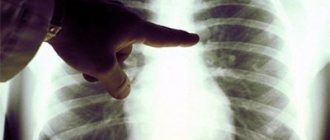How does the syndrome manifest?
CFS has a fairly broad symptomatic picture. Its symptoms are not specific, and given that many of them accompany other diseases, it is quite difficult to diagnose CFS. As a rule, the patient manages to visit many specialized specialists before getting on the right path.
The main symptom of this condition is overwhelming fatigue, present for at least 6 months. It accompanies a person even after sufficient sleep or rest. When waking up, the patient already feels tired. In addition, fatigue is present even when he does nothing.
Weakness, malaise, and lack of vital energy tirelessly accompany a patient with CFS. His performance drops sharply. A previously active, cheerful person behaves like an amoeba. Work is difficult for him; he can spend all day working on one task without ever bringing it to fruition.
Things around the house are also not going well. It is difficult to force oneself to fulfill one’s duties, and more often the patient simply ignores them, lying on the couch all day and doing nothing.
Although people with chronic fatigue syndrome feel sleepy all the time, even during the day, they often have difficulty falling asleep. They are often accompanied by insomnia or restless sleep.
Other common signs of CFS include apathy and depression. Patients are accompanied by a bad mood and lose interest in everything that is happening. Even what previously aroused special interest now loses any significance. The need for sex is also reduced or absent altogether. The patient is irritable and aggressive.
Cognitive abilities decrease. The person becomes inattentive. Makes mistakes in his work. To avoid this, he performs his duties very slowly and double-checks everything several times.
Perception and memory suffer. Sometimes it happens that when looking at a document or text, the patient does not understand what it says. Information is also not perceived by ear. A person forgets even what he heard a few minutes ago.
Physiological symptoms are also varied. Among them:
- causeless headaches;
- hyperthermia up to 38°;
- enlarged lymph nodes in the neck and armpits;
- pain in large joints and muscles for no reason, and today the pain is present in the knees, and tomorrow in the elbows. That is, her character is fickle;
- exercise intolerance. The slightest physical activity leads to complete exhaustion. For example, going to the store closest to your home is comparable to running several kilometers;
- frequent pharyngitis and colds;
- allergies.
Such people often experience irritable bowel syndrome. It is functional in nature, manifested by abdominal pain, diarrhea or constipation, and changes in the character of stool. False urges to defecate, flatulence, and a feeling of full intestines appear.
A girl suffering from CFS describes her condition as “on her last breath”: a little more, and she will not be able to take another breath. She has no strength at all, although she doesn’t do anything special. I just want to sleep and eat. Everything is annoying, I want peace and quiet. Conversations with people are tiring and cause unbearable headaches.
Treatment of emotional burnout
Treatment depends on the cause and must be individualized for each patient. Self-medication with sleeping pills is strictly not recommended, as it can lead to drug dependence.
If burnout is work-related, the doctor may recommend taking a vacation, as well as the following steps to correct the syndrome:
- Psychotherapy. Cognitive behavioral therapy involves gradually exposing the patient to anxiety-provoking situations and helping them change their behavioral responses.
- Medicines. In some cases, antidepressants (serotonin reuptake inhibitors) may be prescribed. Dopamine and norepinephrine reuptake inhibitors are sometimes combined. These substances aim to increase the concentration of these neurotransmitters in the intersynaptic spaces, the connection points between neurons.
There are also natural treatments for burnout:
- Relaxation techniques. They reduce stress and improve heart function, even if you spend just a few minutes a day.
- Hypnosis. It allows a person to mobilize their own resources to cope with burnout.
- Yoga and tai chi. Their practice is associated with an increase in BDNF, a neuronal building factor and plasticity. Therefore, practicing yoga or tai chi can prevent burnout or improve the well-being of a person with this syndrome.
- Changing your diet. In particular, a diet rich in magnesium may be recommended - its deficiency is involved in numerous mechanisms associated with stress and burnout. Taking magnesium helps prevent and recover from burnout.
At the same time, some products reduce the absorption of magnesium and increase its excretion in the urine:
- caffeine found in coffee, some carbonated drinks and energy drinks;
- excess phosphorus (dairy products, soft drinks enriched with phosphoric acid);
- alcohol.
Foods rich in magnesium include seafood, sardines, Brazil nuts, nuts, hazelnuts, almonds, green leafy vegetables, buckwheat, legumes.
Other methods for correcting burnout syndrome include homeopathy and herbal medicine.
Anti-Aging Medicine Seminars Gain knowledge based on evidence-based medicine first-hand from the world's leading experts. As part of the Anti-Age Expert Modular School, in-person two-day seminars are held every month, where the intricacies of anti-age medicine are revealed to doctors of more than 25 specialties
Find out more
Why does the disorder occur?
The disease received its official name in 1984. Then in Nevada, having experienced an epidemic, more than two hundred people showed its symptoms. Although cases of CFS were known earlier, back in 1934.
It is believed that chronic fatigue syndrome is a disease of large cities, where there is a frantic pace of life, as well as those people whose daily activities are particularly responsible. It most often affects women aged 25–50 years.
The pathogenesis of the disorder is associated with disruption of the functioning of the centers of the autonomic nervous system, or more precisely, with the inhibitory effect of certain zones on them. But the reason for this failure has not yet been established.
Possible causes of the syndrome are divided into physiological and psychological.
Among the physiological theories, the most promising is viral infection. Viruses, one way or another, capable of triggering CFS:
- Epstein–Barr virus;
- Coxsackie;
- herpes type 6;
- flu;
- cytomegalovirus;
- enterovirus;
- retrovirus;
- hepatitis C virus.
Another etiological factor, according to scientists, is an inadequate immune response.
It can be caused by infections, chronic diseases and other reasons. In this case, there is an increase in the number of some cells (in particular, cytokines) and a decrease in the level of others. Overall, this leads to immune overactivity. Excessive physical activity over a long period of time can also cause chronic fatigue syndrome. This is due to the accumulation of lactic acid in the muscles and the inability to perform active movements.
Other suspected physiological causes of CFS are known:
- disturbance of intestinal microflora;
- decreased L-carnitine levels;
- poor nutrition, causing vitamin deficiency, mineral deficiency;
- intoxication.
Among the psychological risk factors are those that deplete the nervous system. First of all, these are chronic stresses that act systematically, monotonously, but significantly undermine the psycho-emotional state of a person.
This group also includes lack of sleep, improper daily routine, mental overstrain, and a sedentary lifestyle.
The girl worked at a fast and intense pace for several years. Constant flights, nervous and physical stress led to the fact that one day, after suffering from a cold, she suddenly felt very unwell.
The disease had long ago receded, but the girl’s strength never came. Gradually the fatigue increased. It got to the point that she could only wash herself while sitting. Physical activity did not bring the desired result. One day, after doing her morning exercises and getting to the subway, she cried from exhaustion. Pain appeared in the eyes, attention decreased significantly, arms and legs felt excessively heavy. My head and my whole body ached.
Problems with sleep, depression, giving up usual hobbies - this is an incomplete list of the torments that the girl had to face. As a result, the diagnosis of chronic fatigue syndrome became the basis for her condition.
Bibliography:
- IACFS/ME: Primer for Clinical Practitioners. Members of the IACFS/ME Primer Writing Committee, Fred Friedberg, Ph.D., Chairperson Stony Brook, 2014, New York, USA.
- Yunus, M. B. (2007). Role of central sensitization in symptoms beyond muscle pain, and the evaluation of a patient with widespread pain. Best Practice & Research Clinical Rheumatology, 21(3), 481-497.
- Nakatomi Y, Mizuno K, Ishii A, Wada Y, Tanaka M, Tazawa S, Onoe K, Fukuda S, Kawabe J, Takahashi K, et al. J Neuroinflammation in Patients with Chronic Fatigue Syndrome/Myalgic Encephalomyelitis: An C-(R)-PK11195 PET Study. Nucl Med. 2014 Jun; 55(6): 945-50. Epub 2014 Mar 24.
- Dr. Miguel B. Royo Salvador (1996), Siringomielia , escoliosis y malformación de Arnold-Chiari idiopáticas, etiología común (PDF). REV NEUROL (Barc); 24 (132): 937-959.
- Dr. Miguel B. Royo Salvador (1996), Platibasia , impresión basilar, retroceso odontoideo y kinking del tronco cerebral, etiología común con la siringomielia , escoliosis y malformación de Arnold-Chiari idiopáticas (PDF). REV NEUROL (Barc); 24 (134): 1241-1250
- Dr. Miguel B. Royo Salvador (1997), Nuevo tratamiento quirúrgico para la siringomielia , la escoliosis , la malformación de Arnold-Chiari , el kinking del tronco cerebral, el retroceso odontoideo, la impresión basilar y la platibasia idiopáticas (PDF). REV NEUROL; 25 (140): 523-530
- M. B. Royo-Salvador, J. Solé-Llenas, J. M. Doménech, and R. González-Adrio, (2005) “Results of the section of the filum terminale in 20 patients with syringomyelia , scoliosis and Chiari malformation .” (PDF). Acta Neurochir (Wien) 147:515–523.
- M. B. Royo-Salvador (1992), “Aportación a la etiología de la siringomielia ,” Tesis doctoral (PDF). Universidad Autónoma de Barcelona.
- M. B. Royo-Salvador (2014), “Filum System® Bibliography” (PDF).
- M. B. Royo-Salvador (2014), “Filum System® Guía Breve.”
What are the dangers of ignoring CFS?
The problem with the disease is that many domestic doctors do not recognize its official existence. Accordingly, such a diagnosis is not made in all cases that require it. At the same time, the malaise of such people is attributed to the presence of chronic diseases and they are sent to all possible doctors.
In other cases, they consider it a manifestation of laziness. At the same time, the patient not only does not receive sympathy and understanding, but is also subjected to ridicule, reproaches and ignorance of his condition.
Meanwhile, the disease poses a serious threat to both the physical and psychological state of a person . Its second name is myalgic encephalomyelitis. The term symbolizes that the pathological process covers not only the mental sphere, but also affects physical well-being. In particular, as the concept suggests, on the muscles and brain.
Constant inactivity, atony, and lack of physical activity in chronic fatigue syndrome lead to muscle weakness, and in severe cases, muscle atrophy. They lose their volume, and, accordingly, the ability to fully carry out movement. The enrichment of body tissues with oxygen decreases, bones become brittle and brittle.
Problems with blood pressure appear. Vessels lose their tone. Moreover, if a person tries to get out of bed, there may be a disruption in blood circulation, resulting in its outflow from the head. Simply put, fainting is likely.
Physical inactivity also leads to fibromyalgia – muscle pain of varying severity. They can be so strong that a person cannot move and loses his ability to work. But he is not entitled to disability, as well as the benefits associated with it, because chronic fatigue syndrome, even if it is officially established, does not provide such powers.
Apathy and reluctance to gain new knowledge, grow and develop cause a decrease in mental activity. Partial amnesia occurs, and it becomes more difficult to establish logical connections. There are times when it is simply difficult for a person to speak or even think. Such a gradual extinction of thought processes, if not stopped in time, leads to degradation.
The lack of strength and vitality leads to the fact that people with CFS are less and less likely to leave the house. This lifestyle gradually leads to social isolation. Severing contacts with acquaintances and friends smoothly develops into a situation where a person is left alone, alone with his thoughts and problems. Together with concerns about one’s health, this often becomes a cause of suicide.
Of course, extreme illness does not happen very often. But it is worth noting that in quite a large number of cases, patients themselves find the problem of their ailment thanks to the Internet, studying information and looking for an explanation for their condition. As a rule, this happens after long, unproductive wanderings to doctors.
Dissection of the filum terminale using the Filum Sistem® method
Advantages
1. The tension on the spinal cord caused by a too short or tight filum terminale is eliminated.
2. Using the minimally invasive surgical technique of the Chiari Institute of Barcelona, the surgical time is 45 minutes. Stay in the hospital for about a day. The post-operative period is short and without serious restrictions. No admission to the intensive care unit. No blood transfusion.
3. Its use reduces the risk of mortality to zero. No serious complications.
4. Improves symptoms and stops the development of pathologies associated with filum terminale disease.
How to make a diagnosis
A diagnosis of CFS can be made if the following criteria are met. The presence of 2 major signs is required. This is constant fatigue with decreased activity during the day, lasting more than 6 months. However, it does not go away even after proper rest, and can intensify.
The second main criterion is the absence of somatic and mental illnesses. For this purpose, the patient is referred for examinations and consultations with specialized specialists: a cardiologist, gastroenterologist, neurologist, etc. The impact of the psychotraumatic factor is taken into account.
Having these 2 points is not enough. The presence of 6–8 other (minor) symptoms of the disease is also necessary.
With proper and timely treatment, complete recovery occurs. But there is a possibility of relapse under favorable conditions, for example, when exposed to stress factors or after an illness. In rare cases, the syndrome leads to serious consequences.
Prognosis and prevention
Chronic fatigue syndrome must be treated promptly. In patients who do not consult doctors, symptoms worsen, immune defenses are destroyed, and multiple somatic diseases appear.
If the causes of CFS are eliminated, comprehensive treatment is carried out, and all medical recommendations are followed, then a complete cure occurs. For preventive purposes, it is recommended to lead an active lifestyle, do not get overwhelmed at work, go out into nature more often, eat well and relax in absolute silence.
It is important! Do not turn a blind eye to the alarming symptoms of CFS; be sure to make an appointment with neurologists at the CELT clinic for diagnosis, identification of the causes and treatment of the disease.
Make an appointment through the application or by calling +7 +7 We work every day:
- Monday—Friday: 8.00—20.00
- Saturday: 8.00–18.00
- Sunday is a day off
The nearest metro and MCC stations to the clinic:
- Highway of Enthusiasts or Perovo
- Partisan
- Enthusiast Highway
Driving directions
How can CFS be cured?
The quality of treatment for the syndrome is influenced by the patient’s awareness that his condition is a consequence of a real disease, and not just overwork, and it requires adequate therapy.
First of all, it is necessary
to relieve the human nervous system and reduce psycho-emotional stress .
Eliminate activities that cause a lot of stress and try not to overload your day with too many things to do. In some cases, when it is difficult for the patient to understand the state of affairs, psychotherapy comes to the rescue. It is aimed at developing in the patient an adequate perception of reality and assessment of his situation, helps him understand how to correctly and rationally distribute the load during the day in order to avoid overwork, teaches stress tolerance and methods of proper rest.
Auto-training and relaxation help you relax and redirect your attention. They also instill in the patient behavioral programs designed to harmonize his internal state, relieve tension, and tune into a positive mood.
Medications can also be used to treat CFS :
- antidepressants and tranquilizers;
- antiallergic drugs;
- enterosorbents;
- mineral complexes. Particular attention is paid to magnesium preparations. It is believed that it regulates energy metabolism in the body. It is its deficiency that causes loss of strength and rapid fatigue;
- L-carnitine preparations;
- vitamins, especially group B.
Among the physical procedures , massage, physical therapy, water procedures, including contrast showers, are very useful.
Special training programs are now gradually spreading , for example, Lightning Process, The Gupta Program. According to the developers of these programs, chronic fatigue syndrome appears against the background of brain dysfunction. If you return him to normal activity, this will help get rid of a number of problems.
The trainings are based on the neuroplasticity of the brain, that is, its ability to restructure itself. The brain seems to reboot and begins to work according to new rules.
Changes occur when a person begins to work on himself. An individual set of exercises is selected for him, adapted to his level of development. As work progresses, they become more complex. Exercises must be done systematically.
This program of techniques makes the brain work more productively, strengthens it and improves it. It makes it more adaptive, allowing it to adapt faster and better to changing environmental conditions, and also improves mental activity and memory.
At the moment, there are a sufficient number of such systems. Each of them works according to its own scheme, and has in its arsenal a variety of techniques and collections of exercises and auto-trainings. They help fight not only CFS, but also other mental disorders such as depression, anxiety, phobias, etc.
One woman suffered from CFS for 20 years and did not leave the house. But three days of training in one of these programs changed her enough that she was able to run a marathon.
Many of the authors of such programs themselves once suffered from various disorders. But they were able to get rid of them by retraining their brain and are now in a hurry to share their experience for the benefit of others.
Filum terminale disease
After the research of Dr. Royo Salvador and his doctoral dissertation (1992), it was found that several diseases whose cause was previously unknown, such as: Arnold Chiari I syndrome, idiopathic Syringomyelia and Scoliosis, Platybasia, Basilar Impression, Axial vertebral tooth displacement, An angular bend at the level of the arch of the atlas is part of a new pathology - Diseases of the filum terminale - and arises for the same reason: tension in the spinal cord and the entire nervous system. The tension force of the entire nervous system during filum terminale disease is present during the formation of all human embryos; to a greater or lesser extent, everyone suffers from its consequences and various forms of manifestation and intensity. The following diseases may be associated with filum terminale disease: intervertebral hernias, some cerebrovascular insufficiency syndromes, facet syndrome, Bostrup syndrome, fibromyalgia, chronic fatigue, nocturnal enuresis, urinary incontinence and acute paraparesis. For accurate diagnosis, selection of treatment and monitoring of a patient with filum terminale disease, the Filum System® method was created.
Daily regime
No matter how trivial it may sound, following the correct daily routine is a very important point in the treatment and prevention of chronic fatigue syndrome. It is as follows:
- balanced diet, without spicy and fatty foods, psychostimulating drinks (coffee, strong tea). Alcohol will have to be eliminated completely. Food should be rich in vitamins and other useful components;
- rational change of work and rest. Mental stress is needed for the brain. This develops thinking, memory, attention, and can even delay the development of senile dementia. But everything is good in moderation. It is important not to overexert your brain. To do this, set aside time during the day for rest. If you do monotonous, sedentary work, be sure to take a break every 2 hours to refocus. If the work is associated with occupational hazards: noise, vibration, etc., this is simply necessary;
- physical activity is a must. But they must be dosed so as not to exhaust yourself. It would be good to choose a sport that brings pleasure and good impressions, after which you are recharged with energy. Outdoor sports are especially good. Choose running, race walking, horseback riding. By the way, physical exercise helps not only to tighten the body. This is also a great way to relieve emotional stress and give vent to emotions;
- One of the main conditions for getting rid of CFS is normalizing sleep. You need to sleep at least 8 hours a day. If you have problems falling asleep, you need to protect yourself from mental and physical stress before bed. It may be useful for you to sleep for a couple of hours during the day, but only if it does not interfere with falling asleep at night;
- It is essential to allow yourself to relax. To do this, use the methods that suit you. For some it will be meeting with friends, for others it will be listening to music or reading a book. Aromatherapy, warm bath, meditation, pets - whatever;
- A good way out of the situation is to change the situation. Take a vacation and go on a trip. This will help you take your mind off the routine, get new emotions and impressions, so to speak, “invigorate” the psyche and make it work - perceive, analyze, remember new things;
- of course, the abolition of bad habits or at least a gradual abandonment of them;
- try to avoid negative experiences. Limit communication with people you find unpleasant, ignore depressing information on TV, the Internet or the newspaper;
- Use soothing teas to tone the nervous system.
To get rid of chronic fatigue syndrome, you must follow all the recommendations in their entirety. Only a comprehensive influence will help improve the psycho-emotional background, eliminate tension and fatigue.
People with CFS often have no idea what caused their dejected state. Adequate treatment of the syndrome is possible only after understanding the essence of the problem and intensive work on oneself. The most difficult step is the first step; sometimes people don’t understand where to start.
You shouldn't fight the disease alone. Contact a specialist, get information and start acting immediately.
Vitamin deficiency
It is known that asthenia can be caused by a deficiency of certain vitamins and microelements, in particular vitamin D. Low levels of this vital nutrient in the blood can have a negative impact on performance and quality of life in general7. The results of clinical studies indicate that a decrease in the level of sunshine vitamin in the blood of women less than 29 ng/ml is associated with significantly more frequent complaints of increased fatigue compared with a level of more than 30 ng/ml8.
Many biochemical processes occurring in the body every day are accompanied by fluid loss, which is important to compensate. Research shows that even small amounts of fluid loss can lead to decreased energy levels, decreased concentration, and increased fatigue9.











